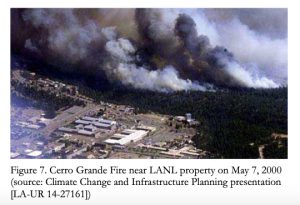Los Alamos National Laboratory (LANL) has had two major wildland fires — the Cerro Grande Fire in 2000 and the Las Conchas Fire in 2011. Each fire burned partially on Lab property within miles of several nuclear facilities. LANL’s wildfire prevention should be 100% in place and constantly updated. But a February 1, 2021, report by the DOE Inspector General found that activities designed to reduce the impact from wildland fire had not been fully implemented at LANL. The DOE-IG found that while the contractor, Triad, had identified fire risks, it had not completely implemented all measures to prevent serious fires.
The DOE-IG specifically found that:
· mitigation measures such as tree thinning were not always performed, and therefore increased the potential for another devastating fire like the Cerro Grande Fire
· not all fire roads were maintained to ensure safe passage for firefighters and equipment responding to wildland fires in undeveloped areas of LANL
· contractor officials could not demonstrate that annual planning and preparedness activities were completed
· the contractor had not developed a comprehensive, risk-based approach to wildland fire management at LANL
· Although DOE”s Los Alamos Field Office was responsible for overseeing contractor performance, it had not reviewed and approved the contractor’s Wildland Fire Plan or conducted assessments of wildland fire management activities

Based on the risk assessment conducted by wildland fire experts, contractor officials determined that fuel levels in deep canyons, which were most prone to active crown fires, were high, and that mitigation was needed in these areas since fire suppression was difficult, and hazard potential extreme. Lowering high fuel loads in forests would substantially reduce the potential for future large, high-intensity wildfires that could threaten to seriously interrupt mission work, as was the case during the Cerro Grande Fire. Yet the DOE-IG stated that necessary mitigation measures to reduce the risk of crown fires, such as tree thinning, were not always performed.
The contractor’s officials indicated that there were approximately 400–500 trees per acre in a particular canyon; however, the ideal number should be 40–50 trees per acre. This was concerning to the DOE-IG since these contractor officials also stated that a contaminated site exists at the bottom of the canyon, which could produce a health risk to the environment and to human health during a fire. The risk of crown fires in canyons was also concerning because several facilities are located on mesas at the tops of the canyons, which could be impacted by a fire. Compounding the issue, the contractor’s Wildland Fire Plan identified the need to manage sections of power lines that cut through forested areas due to increased risk however, vegetation maintenance in buffer zones below overhead power lines was not always completed.
The Los Alamos Field Office had not updated its Fire Protection Program procedure since 2010, which was a year before the 2011 Las Conchas Fire. The contractor did recognize that its Wildland Fire Plan was not being implemented and it initiated different plans to formalize inspection and maintenance programs for fire roads, utility corridors, and defensible space treatments. The DOE-IG stated that, “While these are positive measures, completion of these activities is dependent on continued contractor and Los Alamos Field Office management support. Until actions are fully implemented, LANL is at a higher risk of wildland fire due to unhealthy forest conditions.”
The DOE-IG Report, “The Department of Energy’s Wildland Fire Prevention Efforts at the Los Alamos National Laboratory” is available here.
https://www.energy.gov/sites/prod/files/2021/02/f82/DOE-OIG-21-13_0.pdf
